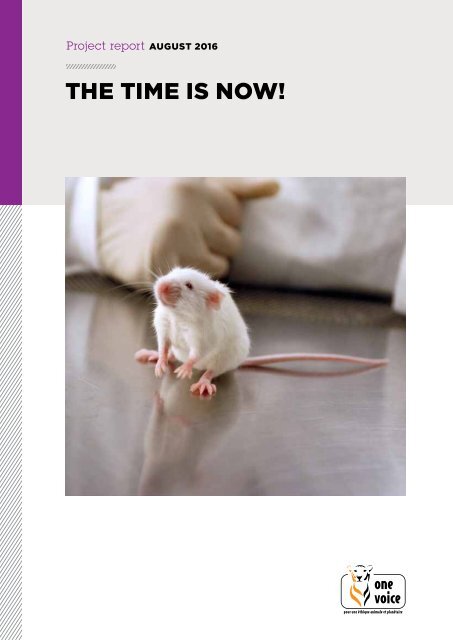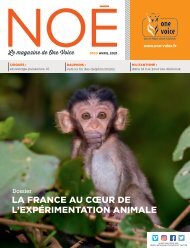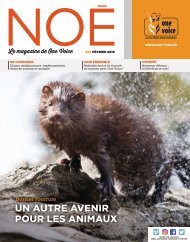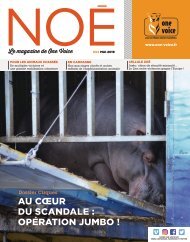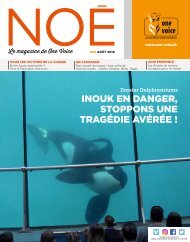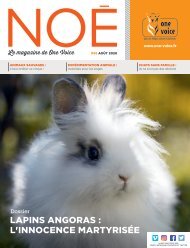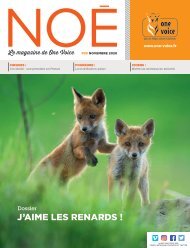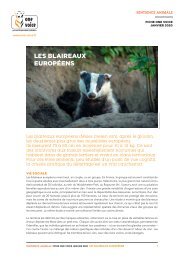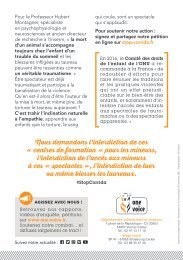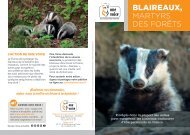The time is now!
Create successful ePaper yourself
Turn your PDF publications into a flip-book with our unique Google optimized e-Paper software.
Project report August 2016<br />
<strong>The</strong> Time <strong>is</strong> Now!
Contents<br />
Introduction..................................................................................... p. 3<br />
General Findings................................................................................. p. 3<br />
Methodology.....................................................................................p. 3<br />
Broken prom<strong>is</strong>es on publication of national stat<strong>is</strong>tics.....................................p. 4<br />
Failure to reduce and replace animal tests...................................................p. 4<br />
Key authorities and national bodies concerning animal experiments:<br />
the lack of transparency . .................................................p. 5<br />
Alternatives to animal testing- attitudes and challenges.................................p. 6<br />
National and European Laws on animal testing.............................................p. 8<br />
Further political correspondence highlighting systemic failure<br />
and res<strong>is</strong>tance by the Government.............................................................p. 9<br />
Conclusion........................................................................................p. 9<br />
references....................................................................................... p. 10<br />
Head office: BP 41 - 67065 Strasbourg<br />
Admin<strong>is</strong>trative and m<strong>is</strong>sions department:<br />
38 rue Saint-Cornély - 56340 Carnac<br />
Tél.: 02 97 52 57 00 - Fax: 02 97 52 57 09<br />
info@one-voice.fr www.one-voice.fr<br />
follow one voice on<br />
vimeo, youtube, facebook and twitter<br />
<strong>The</strong> Time <strong>is</strong> Now! August 2016 2
introduction<br />
Th<strong>is</strong> report <strong>is</strong> provided by One Voice as part of<br />
the European Coalition to End Animal Experiments (ECEAE)<br />
project ‘<strong>The</strong> Time <strong>is</strong> Now’.<br />
It aligns with the project aims of identifying (in France)<br />
as many examples of proposals or predictions by min<strong>is</strong>ters,<br />
government bodies or reports by committees or research<br />
establ<strong>is</strong>hments of ways to reduce the number of animal<br />
experiments in the future, or concrete predictions that<br />
the number of animal experiments would fall by 2015.<br />
General Findings<br />
Extensive research has been carried out in compiling th<strong>is</strong><br />
report, in accordance with details requested within the<br />
ECEAE project as follows;<br />
Project Details<br />
• What <strong>is</strong> the body or individual who made the statement/<br />
recommendation?<br />
• What <strong>is</strong> their status? (Min<strong>is</strong>ter, committee, etc.)<br />
• What exactly did they say? Please include any reservations<br />
or ways in which they could say that they did not<br />
really mean it.<br />
• What has actually happened?<br />
General findings are that the<br />
national authorities in France<br />
are reluctant to provide any targets<br />
or pledges on reduction or<br />
replacement of animal experiments.<br />
Indeed, specific quotes<br />
and references to predictions<br />
that animal testing on French<br />
soil would fall by 2015 (or even<br />
prior to th<strong>is</strong>) have been very<br />
challenging to find, as it would<br />
seem that government bodies,<br />
min<strong>is</strong>ters or politicians are simply<br />
unwilling (or perhaps unable or d<strong>is</strong>couraged in some<br />
cases) to make such predictions at the outset. Repeated<br />
requests from One Voice to provide information on animal<br />
experiments have received no replies from the national<br />
bodies concerned.<br />
However, despite a clear lack of government transparency<br />
and accountability in reducing animal numbers, in<br />
th<strong>is</strong> report One Voice provides the results of its research<br />
into all available evidence and resources on the current<br />
situation concerning animal testing in France, as well as<br />
initiatives to support the 3Rs. Much of the information<br />
“Not only France has<br />
status as the highest user of<br />
animals in experiments in<br />
the EU, but the continued<br />
active encouragement<br />
within the national research<br />
community to conduct<br />
animal testing.”<br />
available <strong>is</strong> generic, evasive or vague (for example, mere<br />
repetition by national research bodies of the Russell and<br />
Birch ‘3Rs’ criteria, rather than meaningful explanation of<br />
how the 3Rs are specifically being applied in such institutions,<br />
or any genuine commitments to targets to reduce<br />
or replace animal testing 1 .<br />
One Voice believes th<strong>is</strong> makes a strong case to carry<br />
forward as part of the project, at both national and European<br />
level, especially given France’s status as the highest<br />
user of animals in experiments in the EU and even more<br />
critically, the continued active encouragement within the<br />
national research community to<br />
conduct animal testing 2 . <strong>The</strong>refore,<br />
where the authorities have<br />
so far failed to provide predictions<br />
or targets, one of the next<br />
key steps <strong>is</strong> to establ<strong>is</strong>h a clear<br />
and firm lobbying strategy, to<br />
make the authorities provide<br />
such estimates, to which they<br />
can then be held accountable.<br />
Methodology<br />
In compling th<strong>is</strong> report, a number<br />
of sources of documentation<br />
have been searched; these<br />
include parliamentary correspondence such as written<br />
questions and responses from the Senate and National<br />
Assembly; reports and written statements (for example<br />
on government research department websites) reports<br />
by scientific and political committees and press releases,<br />
as well as review of national pro-animal research materials.<br />
A comprehensive search of documentation at both<br />
French and EU level has been made.<br />
Examples of political correspondence, reports and other<br />
information produced in previous years have been used<br />
to demonstrate a lack of commitment or failure to act.<br />
<strong>The</strong> Time <strong>is</strong> Now! August 2016 3
Broken prom<strong>is</strong>es on publication<br />
of national stat<strong>is</strong>tics<br />
<strong>The</strong> competent authority for providing up to date annual<br />
stat<strong>is</strong>tics on animal experiments, the Min<strong>is</strong>try for Higher<br />
Education and Research 3 has provided no new annual<br />
figures since 2010. Even these were provided as part of<br />
the last EU wide report 4 , rather than nationally publ<strong>is</strong>hed.<br />
Th<strong>is</strong> <strong>is</strong> despite the min<strong>is</strong>ty stating on it’s animal research<br />
homepage 5 in reference to release of stat<strong>is</strong>tics ‘As part of<br />
the implementation of the new European Directive (Directive<br />
2010/63 / EU), th<strong>is</strong> rate will become annual from 2014<br />
and its format will undergo major changes.’<br />
It would seem that th<strong>is</strong> <strong>now</strong> puts France in breach of<br />
Directive 2010/63/EU which states under Article 54 (2) that<br />
‘Member States shall collect and make publicly available,<br />
on an annual bas<strong>is</strong>, stat<strong>is</strong>tical information on the use of<br />
animals in procedures, including information on the actual<br />
severity of the procedures and on the origin and species<br />
of non-human primates used in procedures. Member<br />
States shall submit that stat<strong>is</strong>tical information to the Comm<strong>is</strong>sion<br />
by 10 November 2015 and every year thereafter.’<br />
Has the government submitted th<strong>is</strong> data by the above<br />
deadline? If so where <strong>is</strong> it and when will new national<br />
figures be released? Th<strong>is</strong> lack of transparency and<br />
failure to publ<strong>is</strong>h previous annual stat<strong>is</strong>tics was also<br />
recently highlighted in a parliamentary question by Laurence<br />
Abeille MP of the EELV party 6 . Ms Abeille also<br />
highlights in the same written question, the failure of<br />
the government to publ<strong>is</strong>h non-technical summaries, as<br />
required under Article 43(3) of the directive. At the <strong>time</strong><br />
of writing th<strong>is</strong> report, a response from the min<strong>is</strong>try <strong>is</strong> still<br />
outstanding.<br />
To provide compar<strong>is</strong>on, since the last stat<strong>is</strong>tics provided<br />
by France in 2010 for the EU report, other member states,<br />
for example the UK, Germany, Austria and the Netherlands<br />
have at least produced national annual stat<strong>is</strong>tics for 2011-<br />
2014 inclusive. How can France not be held to account for<br />
its failure to do the same?<br />
Failure to reduce and replace<br />
animal tests<br />
For two decades, France remains the highest user<br />
of animals in experiments across the EU, when compared<br />
to all other member states, cons<strong>is</strong>tently responsible<br />
for between 20 and 24% of all experiments<br />
since the mid to late 1990s. Figures have remained<br />
well over 2 million animals per year, yet the true<br />
figure <strong>is</strong> likely to be much higher, as national and EU<br />
based collection of figures differs across all countries.<br />
<strong>The</strong> Time <strong>is</strong> Now! August 2016 4
(For example, in the UK in 2011, the total number of animals<br />
used was 3.79 million as declared in the national<br />
report, yet EU figures only report a total of 2.05 million for<br />
the UK in the same year 7 ).<br />
In 2012 it was stated that there were 245 animal research<br />
institutions (INRA, INSERM, CNRS, CEA, universities,<br />
private pharmaceutical companies) and almost 640 experimental<br />
authorizations were granted by the Board of<br />
Control for five years. 8<br />
<strong>The</strong> next EU-wide stat<strong>is</strong>tics are due at the end of 2016.<br />
Th<strong>is</strong> will be the eighth report on the use of animals for<br />
scientific purposes. <strong>The</strong> European Comm<strong>is</strong>sion publ<strong>is</strong>h<br />
these reports every three years and the data collected<br />
from most member states corresponds to two years<br />
earlier, with France usually providing data from three<br />
years earlier. It <strong>is</strong> therefore anticipated that France<br />
will provide figures corresponding to 2013 (or possibly<br />
2014) to be included in the eighth report.<br />
leg<strong>is</strong>lation to animal testing, and for approval of training<br />
of personnel of institutions of animal experimentation.‘<br />
However, questions were ra<strong>is</strong>ed in parliament in 1997,<br />
higlighting the failure of the CNEA a decade after its establ<strong>is</strong>hment,<br />
to be effective in carrying out its role in creating<br />
a comm<strong>is</strong>sion for alternative methods 13 , also highlighting<br />
the fact that two leg<strong>is</strong>lative proposals to set up such a committee<br />
had been rejected. <strong>The</strong> Comm<strong>is</strong>sion stated in its<br />
response that as early as 1991, it had set up a Sub-Committee<br />
on alternative methods, composed of members of<br />
the national comm<strong>is</strong>sion and other selected experts from<br />
academia, research companies, animal protection organ<strong>is</strong>ations<br />
and industry,with three objectives: make an inventory<br />
of the d<strong>is</strong>ciplines for which alternative methods are currently<br />
under review or available; a reflection for a decrease in the<br />
number of animals used and; a role of Coordinator in order<br />
to promote and develop the research carried out in collaboration<br />
by public or private laboratories.<br />
Despite references to the 3Rs<br />
and alternatives to animal testing<br />
elsewhere, the res<strong>is</strong>tance<br />
to change in France <strong>is</strong> clear<br />
from opinions and speculations<br />
in some previous stat<strong>is</strong>tical<br />
reports. For example, in addition<br />
to data provided in the<br />
2002 release, the Min<strong>is</strong>try for<br />
Research emphas<strong>is</strong>ed that there<br />
had been ‘no breakthrough in<br />
alternatives’ and ‘the need for<br />
animal experimentation’. Also<br />
that it <strong>is</strong> ‘difficult to make predictions’<br />
in why certain areas<br />
of animal use may r<strong>is</strong>e or fall, ‘without making any predictions<br />
about the future 9 .’ Such unsolicited opinion in<br />
stat<strong>is</strong>tical reports <strong>is</strong> rare from other member states, who<br />
instead promote work done towards actively reducing<br />
animal use, or highlight progress made in research into<br />
alternative methods.<br />
Key authorities and national bodies<br />
concerning animal experiments:<br />
the lack of transparency<br />
<strong>The</strong> CNEA (Comm<strong>is</strong>sion nationale de l’expérimentation<br />
animale) was set up by the national competent authority<br />
on animal testing (the Min<strong>is</strong>try of Research) in 1987<br />
under article 27 of Decree No. 87-848 on practical experiments<br />
on animals 10 <strong>The</strong> Decree states that the CNEA<br />
meets twice a year (after an amendment in 2001) and its<br />
members change as required. 11 L<strong>is</strong>ts of current members<br />
are available. 12<br />
<strong>The</strong> CNEA <strong>is</strong> ‘responsible for different m<strong>is</strong>sions in the use<br />
of animals for scientific purposes: it provides advice in<br />
particular on any proposed amendment of regulation or<br />
“<strong>The</strong> competent authority<br />
for providing up to<br />
date annual stat<strong>is</strong>tics<br />
on animal experiments,<br />
the Min<strong>is</strong>try for<br />
Higher Education and<br />
Research, has provided<br />
no new annual figures<br />
since 2010.”<br />
<strong>The</strong> response from the min<strong>is</strong>try<br />
also outlined how subsequently,<br />
the CNEA found that there was<br />
‘no match between the status<br />
of the Sub-Committee on<br />
alternative methods and the<br />
actions to be undertaken’, and<br />
that it was appropriate to give<br />
the committee an official recogn<strong>is</strong>ed<br />
identity. Yet it appears<br />
th<strong>is</strong> took a further six years.<br />
Under the CNEA, the National<br />
Committee of Ethical Reflection<br />
on Animal Experimentation<br />
(CNREEA) was finally<br />
announced in 2003 and establ<strong>is</strong>hed a further two years<br />
later (decree of 22 March 2005) 14 .<br />
<strong>The</strong> CNREEA m<strong>is</strong>sion <strong>is</strong> to provide opinions on the ethical<br />
<strong>is</strong>sues ra<strong>is</strong>ed by animal experiments. One of the committees<br />
first actions was to develop the National Charter<br />
on the ethics of animal experimentation, yet th<strong>is</strong> wasn’t<br />
until 2008 15 and provides no focus on alternatives methods.<br />
<strong>The</strong> above demonstrates the painfully slow process of setting<br />
up committees to even ack<strong>now</strong>ledge animal experiments,<br />
not to mention alternatives.<br />
<strong>The</strong> parliamentary response of 1997 also stated that for<br />
several years, a scientific and financial effort was devoted<br />
to the development and evaluation of methods in vitro<br />
alternatives to animal testing and that such methods are<br />
already used on a large scale in the screening and the<br />
development of products, to reduce ‘significantly’ the<br />
number of animals used. Yet th<strong>is</strong> appears to have made<br />
little or no impact on France’s continued status as the<br />
highest user of animals. Furthermore, as <strong>is</strong> already k<strong>now</strong>n,<br />
<strong>The</strong> Time <strong>is</strong> Now! August 2016 5
information on such funding for alternatives <strong>is</strong> difficult<br />
to obtain, even far more recently, as found by ECEAE’s<br />
2014 report when France (along with some other member<br />
states) failed to provide a response to requests to confirm<br />
amounts of funding devoted to alternatives 16 Yet France’s<br />
scientific research and development (R&D) expenditure<br />
was €46,545 million in 2012 17 .<br />
Extensive searching has failed to find any meaningful<br />
documentation (minutes, notes or other outcomes) of<br />
meetings or reviews of any kind by the CNEA or CNREEA,<br />
other than the National Charter described above 15 .<br />
Neither committee appears to have any status, website<br />
or documentation of its own, instead being referred to<br />
only via government research portals 18/19 .<br />
<strong>The</strong> Min<strong>is</strong>try of Research l<strong>is</strong>ts 126 national ethical committees<br />
(as of 17 Dec 2015) 20 which are overseen by the<br />
CNREEA. While these provide intel on location and animal<br />
research sites (many of which are already k<strong>now</strong>n) they<br />
provide little or no information on what they actually do<br />
or outcomes of any reviews of animal experiments.<br />
For example, CREMEAS (Comité Régional d’Ethique en<br />
Matière d’Expérimentation Animale de Strasbourg) <strong>is</strong> one<br />
such sub-commitee tasked with for example, retrospective<br />
evaluation of animal experiments 21 . However no such<br />
documentation on th<strong>is</strong> evaluation or outcomes appears<br />
to be publicly available. Similarly, <strong>The</strong> GRICE (French<br />
group of interprofessional reflexion on ethics committees<br />
applied to animal research) <strong>is</strong> a team created in 1991 to<br />
‘promote the development of ethics committees’. 22<br />
<strong>The</strong> Min<strong>is</strong>try of Research’s latest status report (June<br />
2015) 23 makes no mention of animal testing or alternatives<br />
at all.<br />
Alternatives to animal testing -<br />
attitudes and challenges<br />
In 2009, Michel Lejeune et Jean-Lou<strong>is</strong> Touraine of the Parliamentary<br />
Office for Evaluation of Science and Technology<br />
presented a very comprehensive report to the Senate<br />
and National Assembly entitled ‘Animal testing in Europe<br />
-What alternatives? What ethics? What governance?’ 24<br />
<strong>The</strong> report was accompanied by a letter, requesting that<br />
the President of the National Assembly chair a study on<br />
the assessment of animal experimentation, as well as<br />
alternative methods available and aimed to address the<br />
need for a balanced rev<strong>is</strong>ion of the (then current) directive<br />
86/609, with a phased implementation of the new<br />
prov<strong>is</strong>ions in addressing critical <strong>is</strong>sues such as research,<br />
<strong>The</strong> Time <strong>is</strong> Now! August 2016 6
development and the validation of alternative methods,<br />
education, training and information and the strategic<br />
involvement of public authorities. Many scient<strong>is</strong>ts<br />
throughout France were consulted in compling the report.<br />
Among other findings, the report provided the national<br />
authorites with seven recommendations; i) Update the<br />
rules on training of personnel,to include among others<br />
the 3Rs and alternative methods; ii) ra<strong>is</strong>e awareness of<br />
animal testing and replacement methods for students;<br />
iii) include alternatives in veterinary training; iv) development<br />
of an internet based care guide for researchers,students<br />
and the public; v) a request that the CNEA and<br />
CNREEA organize educational days for the general<br />
public,students and researchers; vi) create new chairs in<br />
animal testing and alternative methods; vii) promote the<br />
use of alternative methods in education. In courses for<br />
students, the use of live animals or euthanized for th<strong>is</strong><br />
purpose should be prohibited and only film screenings<br />
and use organs or t<strong>is</strong>sues of animals killed for other purposes<br />
must be allowed; include in the curriculum, teaching<br />
elementary principles of animal life, the need to<br />
respect animal and human use<br />
of the animal.<br />
No formal min<strong>is</strong>terial response<br />
to th<strong>is</strong> report could be found.<br />
As already k<strong>now</strong>n, the platform<br />
affliliated with the development<br />
of alternatives in France<br />
<strong>is</strong> FRANCOPA, created in 2007<br />
and ‘dedicated to development,<br />
validation, and d<strong>is</strong>semination of<br />
alternative methods in animal<br />
testing.‘ 25 And part of ECOPA (European Concensus Platform<br />
on Alternatives) FRANCOPA <strong>is</strong> composed mainly of<br />
government research bodies and medical research institutes<br />
26 and states that its activities ‘have been centered<br />
initially on the establ<strong>is</strong>hment of a state of the art on 3R<br />
methods and practices in France, together with recommendation<br />
to the French government’.<br />
FRANCOPA publ<strong>is</strong>hed a report 27 in 2010 on alternatives<br />
to animal experiments in France which was laid before the<br />
Min<strong>is</strong>try of Research. <strong>The</strong> release of th<strong>is</strong> report was preceded<br />
by parliamentary recommendation from the (then)<br />
Min<strong>is</strong>ter of Higher Education and Research who ‘attaches<br />
great importance to alternative methods.’ 28<br />
Some findings were highlighted in the report from a survey<br />
which FRANCOPA conducted at a number of national<br />
animal research institutes, which refer to the (then)<br />
EU directive 86/609. <strong>The</strong> report highlights that financial<br />
support for alternatives <strong>is</strong> ‘rarely possible’ in France and<br />
despite some 3Rs activity across key animal research institutions<br />
and government labs, those carrying it out do not<br />
“Institutes ins<strong>is</strong>t on<br />
the fact that it would<br />
be wrong to think<br />
that the creation of<br />
alternative methods<br />
per se <strong>is</strong> an objective of<br />
fundamental research.”<br />
consider themselves to be focussed primarily on 3Rs due<br />
to lack of funding.<br />
Other challenges stated included low incentive to develop<br />
alternatives, as traditional in-vivo methods are still<br />
considered the gold standard, any 3Rs initiatives are<br />
just considered as advantages as tools for investigation,<br />
rather than drivers for change. For example,’the CNRS<br />
through the internal investigation of teams with approximately<br />
370 employees and €E 1.9 million, reported practice<br />
of the ‘alternative’, without saying that th<strong>is</strong> <strong>is</strong> their<br />
main objective. It’s the same in the INSERM, for some<br />
700 employees that were involved in the internal investigation.<br />
<strong>The</strong>se researchers are using alternative methods,<br />
but institutes ins<strong>is</strong>t on the fact that it would be wrong to<br />
think that the creation of alternative methods per se <strong>is</strong> an<br />
objective of fundamental research’. Another key setback<br />
<strong>is</strong> ‘<strong>The</strong> passage of information between basic research<br />
and industry <strong>is</strong> presently lacking. Fundamental applied<br />
research as carried out by academic and government institutes<br />
could be “bridged” to help industry improve their<br />
present methods.’<br />
Also, there <strong>is</strong> ‘a confused perception<br />
of regulations by the<br />
researchers’. For example they<br />
tend to confuse the regulatory<br />
requirement to use alternative<br />
methods in research vs toxicity<br />
testing; the (then) ’Directive<br />
86/609 applies in all areas<br />
of research and R&D and th<strong>is</strong><br />
same obligation with regard to<br />
‘demonstrations in the regulations<br />
applied to products (eg<br />
studies supporting...safety of products).‘<br />
On the subject of perception, th<strong>is</strong> can also be extended<br />
to the interpretation of ‘alternatives’. For example a brief<br />
PUBMED search of 3Rs publications in France results in<br />
(among others) the RETHINK project, a 2010 review on<br />
the proposed use of minipigs in toxicity testing as ‘alternatives’<br />
to other animals, on the bas<strong>is</strong> that ‘being a food<br />
animal, testing in the minipig may be more acceptable to<br />
the public than animals such as dogs or monkeys.’ 29<br />
As well as outlining its findings, FRANCOPA made some<br />
clear and meaningful recommendations within its 2010<br />
report including;<br />
• abandoning unnecessary animal tests;<br />
• include alternative methods in the teaching of life sciences;<br />
• to identify where research into alternatives <strong>is</strong> needed<br />
and develop incentives to research the 3Rs;<br />
• encouraging k<strong>now</strong>ledge transfer and validation of new<br />
methods;<br />
• Set up of new policies to both reduce animal use and<br />
develop alternatives;<br />
<strong>The</strong> Time <strong>is</strong> Now! August 2016 7
• Communicating the message that alternatives to animal<br />
testing are not just breakthroughs, but ‘good science’.<br />
A full version of the FRANCOPA report (updated in 2012)<br />
<strong>is</strong> available 30 and represents perhaps one of the most<br />
advanced documents for taking further as part of a national<br />
lobbying strategy.<br />
In September 2011, FRANCOPA held a workshop on<br />
‘waiving animal testing for regulatory purposes’. 31 Ronan<br />
Stephan , the (then) director for research and innovation<br />
at the French Min<strong>is</strong>try of Higher Education and Research<br />
stated that “It appears that sharing k<strong>now</strong>ledge and data<br />
<strong>is</strong> necessary in order to get the maximal relevance of the<br />
chosen methods. Th<strong>is</strong> <strong>is</strong> the aim of th<strong>is</strong> event organized<br />
by the FRANCOPA Platform to which the French Min<strong>is</strong>try<br />
of Higher Education and Research fully associates itself.”<br />
As in FRANCOPA’s 2010 survey it was highlighted again<br />
that ‘Technology transfer from basic research to applied<br />
research still needs to be more effective. In order to do<br />
th<strong>is</strong>, it <strong>is</strong> necessary to identify the research carried on<br />
alternative methods and the needs for research and<br />
development.’<br />
However, concrete predictions, statements or targets<br />
on reducing animal numbers are not found and in many<br />
cases, repeated persuasive messages appear to be that<br />
‘animal testing can be reduced, but it will always be<br />
necessary.’<br />
National and European Laws<br />
on animal testing<br />
Reciting any details of national or EU laws on animal testing<br />
are largely irelevant to the aims of th<strong>is</strong> report. However,<br />
to state some brief background, the prov<strong>is</strong>ions of<br />
Directive 2010/63/EU were transposed into national law<br />
(Decree 2013-118) in February 2013 32 . <strong>The</strong> regulation in<br />
France (articles R214-87 to R214-137 of the French rural<br />
code 33 ) has also been updated by the 2013-118 decree<br />
and five orders from February 1st 2013, according to the<br />
2010/63 directive. Th<strong>is</strong> regulation <strong>is</strong> under the responsibility<br />
of the French Min<strong>is</strong>try of Agriculture.<br />
It <strong>is</strong> also relevant to mention, as highlighted in previous<br />
reports by One Voice, the serious failures on the part of<br />
the French Government concerning the application of the<br />
previous European animal experiments directive 86/609,<br />
transposed into national law by the Decree of October 19,<br />
1987. <strong>The</strong> following year, the European Comm<strong>is</strong>sion formally<br />
warned the Government of its intention to sanction<br />
breaches with regard to the proper application of six key<br />
measures of the directive 34 .<br />
<strong>The</strong> Time <strong>is</strong> Now! August 2016 8
Further political correspondence<br />
highlighting systemic failure<br />
and res<strong>is</strong>tance by the Government<br />
In a very comprehensive written question in 2003 35 to the<br />
Min<strong>is</strong>ter of Agriculture, Food, F<strong>is</strong>heries and Rural Affairs,<br />
Sylvie Desmarescaux MP highlighted the overwhelming<br />
opinion of the national public on the <strong>is</strong>sue of animal<br />
experiments on dogs and cats and that 86% felt that<br />
any experiments causing suffering to an animal should<br />
be prohibited. Desmarescaux also ra<strong>is</strong>ed the scientific<br />
report produced by One Voice in March 2003, showing<br />
how France used more cats than any other country in the<br />
EU and the r<strong>is</strong>e in the number of dogs used in laboratories<br />
between 1993 and 1999, asking what measures the<br />
Min<strong>is</strong>try would put inplace to protect animals. In its response,<br />
the Min<strong>is</strong>try not only failed to address the <strong>is</strong>sues<br />
ra<strong>is</strong>ed, but used poor arguments to try and answer them,<br />
for example in response to the r<strong>is</strong>ing number of cats and<br />
dogs used in France, the Min<strong>is</strong>try stated that ‘a compar<strong>is</strong>on<br />
of the absolute numbers of dogs and cats used<br />
for scientific purposes in the Member States would be<br />
unfounded stat<strong>is</strong>tically, insofar as the number of teams<br />
and research institutions <strong>is</strong> variable depending on the<br />
country. With reference to its scientific activity, it <strong>is</strong> therefore<br />
logical that France has a<br />
greater number of certain categories<br />
of animals.’<br />
It <strong>is</strong> not acceptable to simply<br />
state that a bigger country,<br />
with more research labs will use<br />
more animals. Th<strong>is</strong> reply clearly<br />
shows not only a total d<strong>is</strong>regard<br />
for public opinion,but also the government attitude to<br />
use of companion (and other) animals in research both<br />
then and since, with France remaining one of the highest,<br />
if not the highest user of cats and dogs year on year, as a<br />
further ten years of stat<strong>is</strong>tics have shown.<br />
Further MPs in support of ending animal testing also<br />
ra<strong>is</strong>ed the findings of our 2003 report 36 , again emphas<strong>is</strong>ing<br />
the overwhelming majority of public concern for<br />
the suffering of animals used in laboratories. Responses<br />
from the Min<strong>is</strong>try of Research at the <strong>time</strong> suggest a very<br />
reactive, not proactive attitude to both ending animal<br />
testing and use of alternatives, with comments such as<br />
‘Currently only three test methods in vitro have been<br />
validated by the European laboratory used to centralize<br />
all alternative methods, they are used in France.’ Th<strong>is</strong><br />
suggests that France will use alternative methods when<br />
available (and even then with some reluctance) but despite<br />
appearances, makes little or no effort in innovative<br />
research as a member state, to find such new methods.<br />
Th<strong>is</strong> atttitude was again evident during th<strong>is</strong> period,<br />
when the French authorities tried to challenge the forthcoming<br />
EU ban on animal testing for cosmetics 37 and<br />
as previously mentioned, on the failures concerning the<br />
“86% of French felt that<br />
any experiments causing<br />
suffering to an animal<br />
should be prohibited.”<br />
correct application of six of the measures of directive<br />
86/609/EEC.<br />
In response to recent parliamentary questions (for example<br />
to the Min<strong>is</strong>try of Agriculture on the continued use<br />
of primates and the opening of new primate research facilities),<br />
the government has been keen to repeat the mantra<br />
that ‘Since the transposition of the European directive<br />
no 2010/63/EU in France in 2013, the new French regulations<br />
relies heavily on rule 3 R.’ 38/39/40<br />
<strong>The</strong> fact that the Min<strong>is</strong>try simply reproduces th<strong>is</strong> same<br />
response to different questions emphas<strong>is</strong>es its irreverent<br />
attitude to the <strong>is</strong>sue of animal testing. <strong>The</strong> lack of publication<br />
of new stat<strong>is</strong>tics to demonstrate such ‘reliance’ on the<br />
3Rs also means that claims like th<strong>is</strong> are difficult to prove.<br />
Furthermore, it appears that instead of commitments<br />
to reducing or replacing animal tests, efforts are spent<br />
more on continuing to promote the use of animals in<br />
laboratories. For example, one of the members of the<br />
CNREEA <strong>is</strong> AFSTAL (Association Franca<strong>is</strong>e des Sciences<br />
et Techniques de l’Animal de Laboratoire) 41 Including<br />
such members in the CNREEA <strong>is</strong> in biased conflict with<br />
its alleged role as an ethical<br />
review body and the reason for<br />
its establ<strong>is</strong>hment.<br />
Conclusion<br />
In researching and collating<br />
evidence for th<strong>is</strong> report, several<br />
<strong>is</strong>sues have been clear<br />
throughout; the French authorities<br />
continue to place emphas<strong>is</strong> on the promotion of animal<br />
testing and do not set targets in reducing or replacing<br />
animal experiments. <strong>The</strong>refore, we must make them set<br />
them and th<strong>is</strong> gives One Voice significant scope for a campaign,<br />
in which we can engage political and public pressure.<br />
Release of the next EU stat<strong>is</strong>tics later th<strong>is</strong> year will be<br />
particularly useful in assessing the most recent situation,<br />
especially since these may give an indication of France’s<br />
use of animals since the transposition of the new directive.<br />
However, in the mean<strong>time</strong>, One Voice can launch a<br />
sustained lobbying strategy, as part of the ECEAE ‘Time <strong>is</strong><br />
Now’ project, to ensure that, no matter how long it takes,<br />
the authorities are meaningfully held to account.<br />
<strong>The</strong> Time <strong>is</strong> Now! August 2016 9
References<br />
1 http://extranet.inserm.fr/recherche-pre-clinique/l-experimentation-animale/la-regle-des-3-r-reduire-raffiner-remplacer<br />
2 http://www.thelocal.fr/20140106/france-<strong>is</strong>-europes-leader-for-animal-testing<br />
3 http://www.enseignementsup-recherche.gouv.fr/<br />
4 http://eur-lex.europa.eu/legal-content/FR/TXT/PDF/?uri=CELEX:52013DC0859&from=EN<br />
5 http://www.enseignementsup-recherche.gouv.fr/cid70613/enquete-stat<strong>is</strong>tique-sur-l-util<strong>is</strong>ation-des-animaux-a-desfins-scientifiques.html<br />
6 http://questions.assemblee-nationale.fr/q14/14-92580QE.htm<br />
7 https://www.gov.uk/government/uploads/system/uploads/attachment_data/file/115853/spanimals11.pdf<br />
8 http://www.la-croix.com/Ethique/Sciences-Ethique/Sciences/L-experimentation-animale-un-mal-necessaire-_NP_-<br />
2012-09-03-849165<br />
9 http://eur-lex.europa.eu/legal-content/EN/TXT/?uri=CELEX:52005DC0007<br />
10 https://www.legifrance.gouv.fr/affichTexte.do?cidTexte=JORFTEXT000000522762&categorieLien=cid<br />
11 http://ethique.ipbs.fr/joeNominationCNEA.pdf<br />
12 https://www.linkedin.com/title/membre-de-la-%22-comm<strong>is</strong>sion-nationale-de-l’exp%C3%A9rimentation-animale%22<br />
13 http://www.senat.fr/questions/base/1997/qSEQ970600332.html<br />
14 http://ethique.ipbs.fr/comm<strong>is</strong>sionNationale.htm.<br />
15 http://rechercheanimale.org/sites/default/files/charte_nationale_portant_sur_l_ethique_de_l_experimentation_<br />
animale-version_angla<strong>is</strong>e_243581_0.pdf<br />
16 http://www.altex.ch/resources/epub_Taylor_140124.pdf<br />
17 http://publication.enseignementsup-recherche.gouv.fr/eesr/8/l-etat-de-l-enseignement-superieur-et-de-la-rechercheen-france-8.php<br />
18 http://www.enseignementsup-recherche.gouv.fr/cid70598/l-encadrement-reglementaire-de-l-util<strong>is</strong>ation-d-animauxa-des-fins-scientifiques.html<br />
19 http://ethique.ipbs.fr/comm<strong>is</strong>sionNationale.html<br />
20 http://cache.media.enseignementsup-recherche.gouv.fr/file/util<strong>is</strong>ation_des_animaux_fins_scientifiques/22/1/<br />
comiteethiqueea17_juin2013_257221.pdf<br />
21 http://med.un<strong>is</strong>tra.fr/fre/Recherche/C.R.E.M.E.A.S/Reglement-interieur<br />
22 http://www.recherche-animale.org/en/d<strong>is</strong>cover-the-animal-research/ethics/ethics-committees-and-projectauthorization<br />
23 http://publication.enseignementsup-recherche.gouv.fr/eesr/8/l-etat-de-l-enseignement-superieur-et-de-la-rechercheen-france-8.php<br />
24 http://www.assemblee-nationale.fr/13/pdf/rap-off/i2145.pdf<br />
25 http://www.francopa.fr/web/francopa?page=home&out=txt&languageIhm=eng<br />
26 http://www.francopa.fr/web/pdf/francopa/DescriptifGISALTER_avril2015.pdf<br />
27 http://www.francopa.fr/web/pdf/francopa/abstractGISreport.pdf<br />
28 http://www.senat.fr/basile/v<strong>is</strong>io.do?id=qSEQ101216572&idtable=q236059<br />
29 http://www.ncbi.nlm.nih.gov/pubmed/20685395<br />
30 http://www.francopa.fr/web/pdf/francopa/rapportGIS.pdf<br />
31 http://www.francopa.fr/web/pdf/francopa/waiving.pdf<br />
32 http://www.recherche-animale.org/sites/default/files/decret_2013-118.pdf<br />
33 http://www.recherche-animale.org/sites/default/files/c_rural_2013.pdf<br />
34 http://www.senat.fr/basile/v<strong>is</strong>io.do?id=qSEQ030306672&idtable=q170512<br />
35 http://www.senat.fr/basile/v<strong>is</strong>io.do?id=qSEQ030306541&idtable=q170512<br />
36 http://www.senat.fr/basile/v<strong>is</strong>io.do?id=qSEQ030406867&idtable=q170512<br />
37 http://www.cosmeticsdesign.com/Formulation-Science/France-challenges-EU-animal-testing-ban<br />
38 http://questions.assemblee-nationale.fr/q14/14-80037QE.htm<br />
39 http://questions.assemblee-nationale.fr/q14/14-70138QE.htm<br />
40 http://questions.assemblee-nationale.fr/q14/14-39094QE.htm<br />
41 http://www.afstal.com/<br />
Photo credits: One Voice, Unk<strong>now</strong>n.<br />
<strong>The</strong> Time <strong>is</strong> Now! August 2016 10
Our reports, including investigations<br />
and scientific expert<strong>is</strong>es are available on<br />
www.one-voice.fr<br />
NON subventionnée<br />
LIBERTÉ de parole garantie !<br />
Head office: BP 41 - 67065 Strasbourg<br />
Admin<strong>is</strong>trative and m<strong>is</strong>sions department:<br />
38 rue Saint-Cornély - 56340 Carnac<br />
Tél.: 02 97 52 57 00 - Fax: 02 97 52 57 09<br />
info@one-voice.fr www.one-voice.fr


